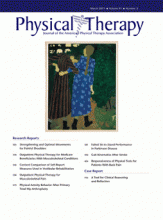Abstract
Background Few studies have examined the responsiveness of physical tests.
Objective The purpose of this study was to explore the responsiveness of 10 physical tests used for patients with back pain in order to illuminate the significance of changes in scores.
Design Cross-sectional and longitudinal designs within a prospective cohort study were applied.
Methods Distribution-based and anchor-based methods were used. Ninety-eight patients (18–65 years of age) with long-lasting back pain were recruited consecutively at an outpatient spine clinic.
Measurements The participants were assessed using 10 physical tests and 2 questionnaires (Hannover Functional Ability Questionnaire and Roland-Morris Disability Questionnaire) at inclusion and after rehabilitation. Six predefined hypotheses for each test were examined regarding the association between changes in scores on the physical tests and the self-report measures of functioning and regarding the relationship of changes in scores on the physical tests and external anchors of important change.
Results Five physical tests demonstrated responsiveness by both distribution-based and anchor-based methods: spondylometry, lateral flexion test, fingertip-to-floor test, lift test, and Back Performance Scale (4 hypotheses confirmed). The minimal important change values were all within the range of the smallest detectable change for individual patients. Responsiveness by distribution-based methods only (3 hypotheses confirmed) was shown for the Biering-Sørensen test and the loaded reach test, whereas little evidence of responsiveness (1 hypothesis confirmed) was shown for the Global Physiotherapy Examination flexibility subscale, the Progressive Isoinertial Lifting Evaluation, and the 15-m (50-ft) walk test.
Limitations The smallest detectable change values were examined in a small sample of patients and need further exploration.
Conclusions Responsiveness varied among the 10 physical tests.
Footnotes
Dr Strand, Ms Anderson, Ms Lygren, Dr Skouen, and Dr Magnussen provided concept/idea/research design. All authors provided writing. Ms Anderson provided data collection, participants, and facilities/equipment. Dr Strand, Dr Ostelo, and Dr Magnussen provided data analysis. Dr Strand, Ms Anderson, and Dr Skouen provided project management. Dr Strand, Ms Anderson, and Ms Lygren provided fund procurement. Dr Strand, Ms Anderson, Ms Lygren, and Dr Skouen provided institutional liaisons. Ms Anderson, Ms Lygren, Dr Skouen, and Dr Magnussen provided consultation (including review of manuscript before submission).
The study was approved by the Regional Committee for Medical Research Ethics, Western Norway, and the Norwegian Social Science Data Services.
Oral presentations of this research were made at the International Association for the Study of Pain Conference; August 17–22, 2008; Glasgow, Scotland, and at the Nordic Physiotherapy Congress; September 23–25, 2009; Oslo, Norway. The research also was presented at the Low Back Pain Forum; June 14–17, 2009; Boston, Massachusetts.
The Norwegian Fund for Postgraduate Training in Physiotherapy is acknowledged for financially supporting the study.
- Received January 13, 2010.
- Accepted November 22, 2010.












